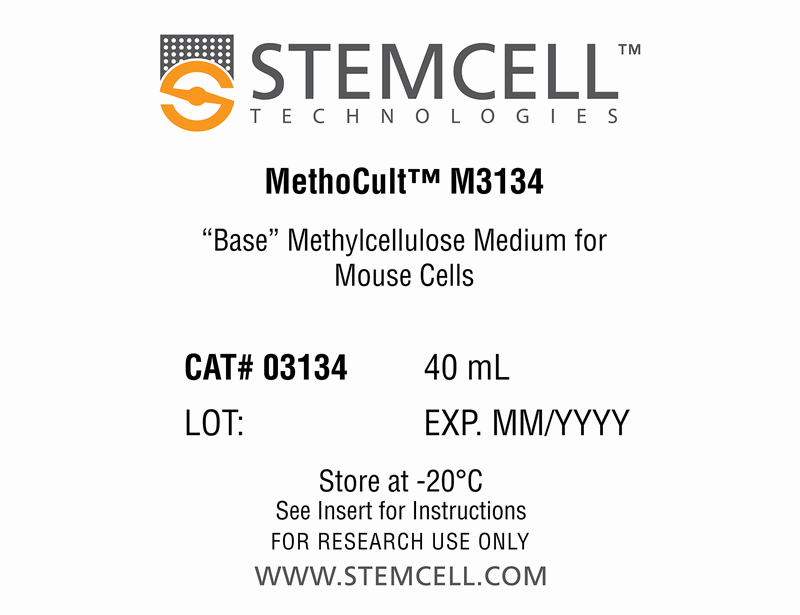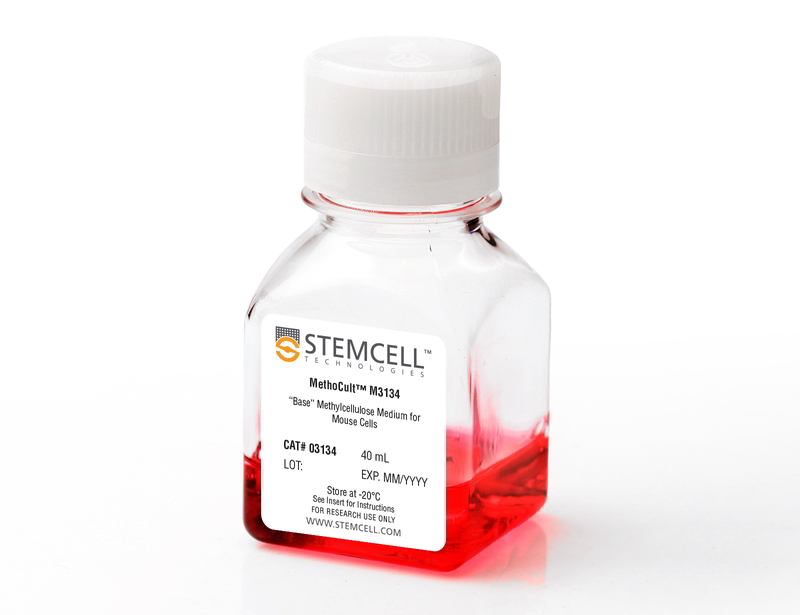MethoCult™ M3134
Base methylcellulose medium for mouse cells
概要
MethoCult™ M3134 is an incomplete medium that contains 2.6% methylcellulose in Iscove's MDM. MethoCult™ M3134 is suitable for the growth and enumeration of hematopoietic progenitor cells in colony-forming unit (CFU) assays of mouse bone marrow, spleen, peripheral blood, and fetal liver, when the appropriate growth factors and supplements are added. This formulation does not contain serum or cytokines.
Browse our Frequently Asked Questions (FAQs) on performing the CFU assay.
Browse our Frequently Asked Questions (FAQs) on performing the CFU assay.
Contains
• 2.6% Methylcellulose
• Iscove’s MDM
• Iscove’s MDM
Subtype
Semi-Solid Media, Specialized Media
Cell Type
Hematopoietic Stem and Progenitor Cells
Species
Mouse
Application
Cell Culture, Colony Assay, Functional Assay
Brand
MethoCult
Area of Interest
Stem Cell Biology
Formulation
Serum-Free
技术资料
| Document Type | 产品名称 | Catalog # | Lot # | 语言 |
|---|---|---|---|---|
| Product Information Sheet | MethoCult™ M3134 | 03134 | All | English |
| Manual | MethoCult™ M3134 | 03134 | All | English |
| Safety Data Sheet | MethoCult™ M3134 | 03134 | All | English |
数据及文献
Publications (17)
Blood 2010 DEC
Lyn- and PLC-beta3-dependent regulation of SHP-1 phosphorylation controls Stat5 activity and myelomonocytic leukemia-like disease.
Abstract
Abstract
Hyperactivation of the transcription factor Stat5 leads to various leukemias. Stat5 activity is regulated by the protein phosphatase SHP-1 in a phospholipase C (PLC)-β3-dependent manner. Thus, PLC-β3-deficient mice develop myeloproliferative neoplasm, like Lyn (Src family kinase)- deficient mice. Here we show that Lyn/PLC-β3 doubly deficient lyn(-/-);PLC-β3(-/-) mice develop a Stat5-dependent, fatal myelodysplastic/myeloproliferative neoplasm, similar to human chronic myelomonocytic leukemia (CMML). In hematopoietic stem cells of lyn(-/-);PLC-β3(-/-) mice that cause the CMML-like disease, phosphorylation of SHP-1 at Tyr(536) and Tyr(564) is abrogated, resulting in reduced phosphatase activity and constitutive activation of Stat5. Furthermore, SHP-1 phosphorylation at Tyr(564) by Lyn is indispensable for maximal phosphatase activity and for suppression of the CMML-like disease in these mice. On the other hand, Tyr(536) in SHP-1 can be phosphorylated by Lyn and another kinase(s) and is necessary for efficient interaction with Stat5. Therefore, we identify a novel Lyn/PLC-β3-mediated regulatory mechanism of SHP-1 and Stat5 activities.
Blood 2009 MAY
Nf1 haploinsufficiency and Icsbp deficiency synergize in the development of leukemias.
Abstract
Abstract
Loss of neurofibromin or interferon consensus sequence binding protein (Icsbp) leads to a myeloproliferative disorder. Transcription of NF1 is directly controlled by ICSBP. It has been postulated that loss of NF1 expression resulting from loss of transcriptional activation by ICSBP contributes to human hematologic malignancies. To investigate the functional cooperation of these 2 proteins, we have established Icsbp-deficient mice with Nf1 haploinsufficiency. We here demonstrate that loss of Icsbp and Nf1 haploinsufficiency synergize to induce a forced myeloproliferation in Icsbp-deficient mice because of an expansion of a mature myeloid progenitor cell. Furthermore, Nf1 haploinsufficiency and loss of Icsbp contribute synergistically to progression of the myeloproliferative disorder toward transplantable leukemias. Leukemias are characterized by distinct phenotypes, which correlate with progressive genetic abnormalities. Loss of Nf1 heterozygosity is not mandatory for disease progression, but its occurrence with other genetic abnormalities indicates progressive genetic alterations in a defined subset of leukemias. These data show that loss of the 2 tumor suppressor genes Nf1 and Icsbp synergize in the induction of leukemias.
The Journal of pharmacology and experimental therapeutics 2009 FEB
Anti-Ccl2 Spiegelmer permits 75% dose reduction of cyclophosphamide to control diffuse proliferative lupus nephritis and pneumonitis in MRL-Fas(lpr) mice.
Abstract
Abstract
Cyclophosphamide (CYC) can control diffuse proliferative lupus nephritis (DPLN) by potent immunosuppression but remains associated with serious and life-threatening complications. Drugs that specifically target mediators of DPLN may help to reduce CYC dose and side effects. Monocyte chemoattractant protein (MCP-1)/CCL2 mediates monocyte and T cell recruitment in DPLN and Ccl2-specific l-enantiomeric RNA Spiegelmer mNOX-E36 neutralizes the biological effects of murine Ccl2 in vitro and in vivo. We injected MRL(lpr/lpr) mice with DPLN from 14 weeks of age with vehicle, weekly 30 mg/kg CYC (full dose), monthly 30 mg/kg CYC (one-fourth full dose), pegylated control Spiegelmer, pegylated anti-Ccl2 Spiegelmer (3/week), pegylated anti-Ccl2 Spiegelmer plus CYC one-fourth full dose and mycophenolate mofetil. At week 24, DPLN and autoimmune lung injury were virtually abolished with CYC full dose but not with CYC one-fourth full dose. The CYC one-fourth full dose/Spiegelmer combination was equipotent to CYC full dose on kidney and lung injury. CD3(+)CD4(-)CD8(-) and CD3(+)CD4(+)CD25(+) T cells and serum interleukin-12p40 and tumor necrosis factor-alpha levels were all markedly affected by CYC full dose but not by CYC one-fourth full dose. No additive effects of anti-Ccl2 Spiegelmer were noted on bone marrow colony-forming unit-granulocyte macrophage counts and 7/4(high) monocyte counts, lymphoproliferation, and spleen T cell depletion. In summary, anti-Ccl2 Spiegelmer permits 75% dose reduction of CYC for controlling DPLN and pneumonitis in MRL-Fas(lpr) mice, sparing suppressive effects of full-dose CYC on myelosuppression and T cell depletion. We propose anti-Ccl2 Spiegelmer therapy as a novel strategy to reduce CYC toxicity in the treatment of severe lupus.
Blood 2008 APR
Rac1 is essential for intraembryonic hematopoiesis and for the initial seeding of fetal liver with definitive hematopoietic progenitor cells.
Abstract
Abstract
Definitive hematopoietic stem and progenitor cells (HSCs/Ps) originating from the yolk sac and/or para-aorta-splanchno-pleura/aorta-gonad-mesonephros are hypothesized to colonize the fetal liver, but mechanisms involved are poorly defined. The Rac subfamily of Rho GTPases has been shown to play essential roles in HSC/P localization to the bone marrow following transplantation. Here, we study the role of Rac1 in HSC/P migration during ontogeny and seeding of fetal liver. Using a triple-transgenic approach, we have deleted Rac1 in HSCs/Ps during very early embryonic development. Without Rac1, there was a decrease in circulating HSCs/Ps in the blood of embryonic day (E) 10.5 embryos, while yolk sac definitive hematopoiesis was quantitatively normal. Intraembryonic hematopoiesis was significantly impaired in Rac1-deficient embryos, culminating with absence of intra-aortic clusters and fetal liver hematopoiesis. At E10.5, Rac1-deficient HSCs/Ps displayed decreased transwell migration and impaired inter-action with the microenvironment in migration-dependent assays. These data suggest that Rac1 plays an important role in HSC/P migration during embryonic development and is essential for the emergence of intraembryonic hematopoiesis.
Blood 2007 OCT
Distinct roles of integrins alpha6 and alpha4 in homing of fetal liver hematopoietic stem and progenitor cells.
Abstract
Abstract
Homing of hematopoietic stem cells (HSCs) into the bone marrow (BM) is a prerequisite for establishment of hematopoiesis during development and following transplantation. However, the molecular interactions that control homing of HSCs, in particular, of fetal HSCs, are not well understood. Herein, we studied the role of the alpha6 and alpha4 integrin receptors for homing and engraftment of fetal liver (FL) HSCs and hematopoietic progenitor cells (HPCs) to adult BM by using integrin alpha6 gene-deleted mice and function-blocking antibodies. Both integrins were ubiquitously expressed in FL Lin(-)Sca-1(+)Kit(+) (LSK) cells. Deletion of integrin alpha6 receptor or inhibition by a function-blocking antibody inhibited FL LSK cell adhesion to its extracellular ligands, laminins-411 and -511 in vitro, and significantly reduced homing of HPCs to BM. In contrast, the anti-integrin alpha6 antibody did not inhibit BM homing of HSCs. In agreement with this, integrin alpha6 gene-deleted FL HSCs did not display any homing or engraftment defect compared with wild-type littermates. In contrast, inhibition of integrin alpha4 receptor by a function-blocking antibody virtually abrogated homing of both FL HSCs and HPCs to BM, indicating distinct functions for integrin alpha6 and alpha4 receptors during homing of fetal HSCs and HPCs.
The Journal of cell biology 2006 SEP
An antiangiogenic neurokinin-B/thromboxane A2 regulatory axis.
Abstract
Abstract
Establishment of angiogenic circuits that orchestrate blood vessel development and remodeling requires an exquisite balance between the activities of pro- and antiangiogenic factors. However, the logic that permits complex signal integration by vascular endothelium is poorly understood. We demonstrate that a neuropeptide�


